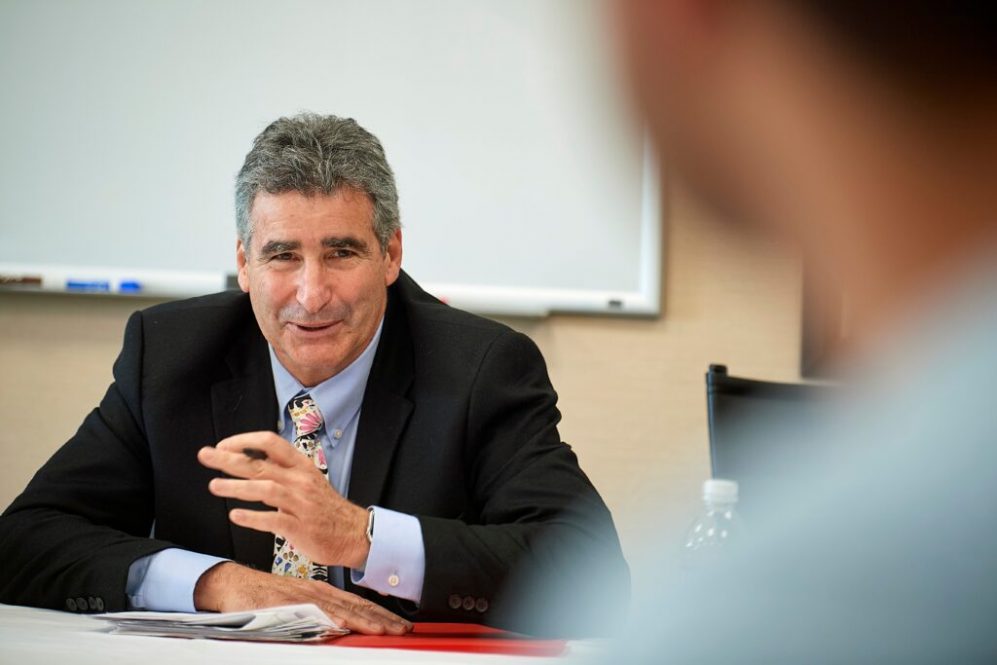By: Eli Freund, Editorial Communications Manager, UConn School of Engineering
After a distinguished career of leadership and scholarship, Optica, an international society aimed at advancing optics and photonics worldwide, has named Electrical and Computer Engineering Professor Thomas C. Katsouleas a 2022 Fellow.
Optica, formerly known as OSA, has inducted over 2,800 members as Fellows since its inception in 1959. According to their website, Optica Fellows are researchers that have served with distinction in the advancement of optics and photonics through distinguished contributions to education, research, engineering, business and society.
Katsouleas, a recent addition to the ECE teaching and research faculty, was previously President of the University of Connecticut from 2019-2021. In that role, he led over 5,000 faculty and staff, and oversaw the education and experiences of over 32,000 students in 14 schools and colleges. Prior to that, Katsouleas was the Provost and Executive Vice President at the University of Virginia, where he led six undergraduate and six professional schools with enrollments of more than 16,000 undergraduates and more than 6,700 graduate students.
Katsouleas earned his bachelor’s degree summa cum laude in 1979 from The University of California in Los Angeles (UCLA), and stayed at UCLA to pursue and receive his Ph.D. degree in physics in 1984. He was a researcher and faculty member at UCLA for seven years after receiving his Ph.D., before joining the University of Southern California faculty as an associate professor of Electrical Engineering in 1991, becoming full professor in 1997. He also was an Associate Dean of University of Southern California’s Engineering School and Vice Provost of Information Technology Services. Katsouleas has deep roots in academe, having served a term as President of the Faculty and Academic Senate at University of Southern California during his time in its engineering school.
He is a leading scholar in the field of laser plasma science and has authored or co- authored more than 250 publications in the field. He has been named outstanding faculty member, received outstanding teaching award, and has supervised dozens of post docs, graduate students, and undergraduate students. For his scholarly contributions and educational leadership, Katsouleas has been named a fellow of the American Physical Society, and fellow of the Institute of Electrical and Electronics Engineers (IEEE). There are strong optics and photonics programs in all of the universities that Katsouleas has held leadership positions as Associate Dean, Dean, Provost, and President, and he has been a strong advocate of research, education, outreach, and entrepreneurship in optics and photonics, making a substantial impact in these fields on a global scale.
While at Duke, he co-created the Grand Challenge Scholars Program of the National Academy of Engineering (NAE), a program now emulated at nearly 100 universities across the U.S. and in several countries around the world. His other professional activities include Co-Chair, National Academy of Engineering’s Advisory Committee on Engineering Grand Challenges for the 21st Century; Co-Chair, 2011 American Society for Engineering Education (ASEE) Global Engineering Education Colloquium, Co-founder of the National Academy of Engineering’s Grand Challenge Scholars Program and K-12 Partners Program; Co-PI and Co-Director of multi-institutional collaboration on Advanced Accelerator and Beam Physics Research at the Stanford Linear Accelerator Center; and Chair of The National Academy of Sciences-National Research Council Panel on Scientific Assessment of Free Electron Laser Technology for Naval Applications (2007-2008).



